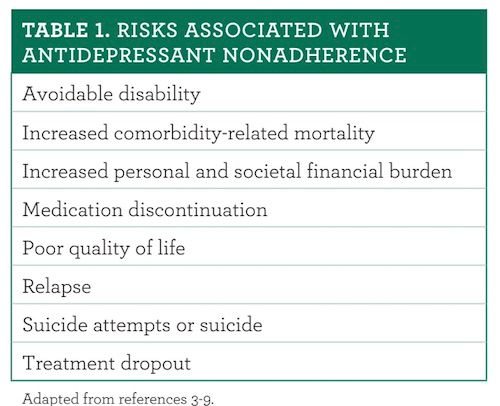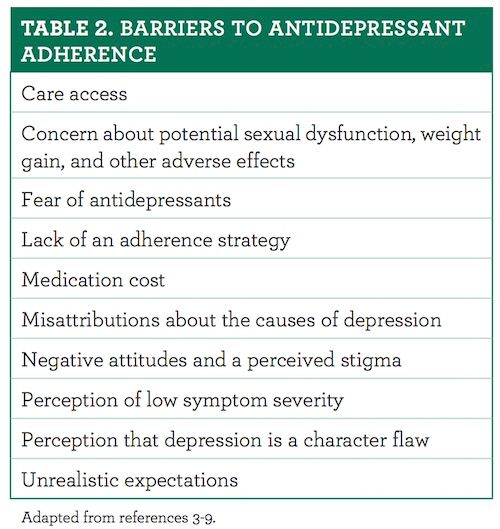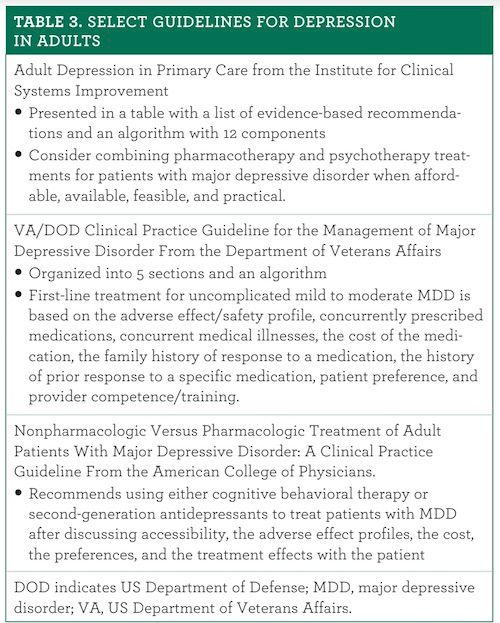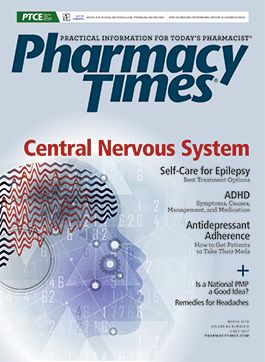Publication
Article
Pharmacy Times
Tool Kit for Increasing Adherence to Antidepressants
Author(s):
Depression, which affects 17% of Americans, is remarkably responsive to antidepressant therapy, but only if the patient actually takes the medication.
Depression, which affects 17% of Americans,1,2 is remarkably responsive to antidepressant therapy, but only if the patient actually takes the medication. Many patients are reluctant to take antidepressants, creating very high rates of nonadherence. Failure to adhere to antidepressant therapy leads to some high-risk outcomes (Table 1). 3-9 Patients who are nonadherent during the first 6 weeks of therapy are at particularly elevated risk.3 Patients who adhere to antidepressant therapy early and continue to take medication as prescribed are more likely to recover from depression and avoid future relapse.4-6

Many patients who have chronic conditions are at elevated risk of depression. Some states include chronic obstructive pulmonary disease, diabetes, heart diseases, and myocardial infarction. Investigators have identified numerous barriers to adherence with antidepressants (Table 2).10,11 Because studies documenting comparative effectiveness among antidepressants are scarce, it is often difficult for clinicians to choose the “right” antidepressant for specific patients.12 For this reason, collaboration with patients, making patients partners in their care, is more important in this condition than in many others.

Pharmacists are generally aware that people may not recognize depression’s symptoms or may attribute their symptoms to aging or a physical complaint. This means that screening is very important. Pharmacists, because of their accessibility and the general public’s high level of trust in them, can ask questions that help patients realize that they may be depressed.13-15 Pharmacists can ask questions about symptoms, such as: Do you prefer to stay home rather than go out and do new things? Have you felt depressed, down, or hopeless in the past 2 weeks? Have you had any thoughts of suicide? How is your energy, and how is your sleep? Pharmacists should also listen carefully to the responses. Pharmacists can counsel that sometimes, those symptoms are associated with depression and responsive to treatment.13-15
Patients who express suicidal ideation need immediate referral to a mental health provider, of course. In this case, the counseling pharmacist needs to ensure that the patient connects with the provider immediately. Calling a family member or the local mental health outreach team is one way to do that. The National Institute of Mental Health has an interactive map that can help pharmacists find nearby mental health services for patients (nimh.nih.gov/outreach/partnership-program/ partner-activities.shtml).16
AN ADHERENCE TOOL KIT
Clinical investigators have conducted a number of studies that have identified useful ways to improve adherence in patients who have depression. A recent randomized clinical trial, Treatment Initiation and Participation Program, used brief psychosocial interventions in middle-aged and older adults with newly diagnosed depression.15 Clinicians took 5 steps with patients who had new prescriptions for antidepressants. First, they reviewed symptoms and the proposed antidepressant regimen and assessed each patient’s potential barriers. Then they helped patients define a personal goal that would be more likely to be achieved if they adhered to their medication. Third, they educated the patients about depression and antidepressants. Fourth, they addressed barriers directly. Finally, they created an inherent strategy and ensured that the patients knew that they could talk to their primary care providers directly about treatment. Patients enrolled in the study who received the study intervention were 5 times more likely to maintain adherence rates of greater than 80% in the first 6 weeks. They were also more likely to sustain their high adherence rates for 3 months.15
Investigators from Mayo Clinic in Rochester, Minnesota, recently published a study that indicates that using a decision support tool, the Depression Medication Choice decision aid, helped clinicians collaborate with patients to select antidepressants that they would be more likely to take. The tool provides information about patients’ 5 most common concerns: sleep, weight change, sexual issues, cost, and stopping approach. The investigators found that the tool effectively engaged patients in the medication selection process, though it had no effect on adherence. This tool is also available digitally at xiaoxuezhang.info/decision_aid/#!/. Its layout and colorful design make it easy to discuss options, and users can select medication and receive concise summaries.12
CONCLUSION
A final tool is familiarity with guidelines for treatment of depression. It is critical to align advice with the best available evidence and practices. This can be a daunting task, as numerous organizations have created guidelines, and many of them speak to specific populations (eg, cancer, obesity, or postmyocardial infarction). Table 3 lists several that can be extremely useful. They can be found at guidelines.gov.

Jeannette Y. Wick, RPh, MBA, FASCP, is the assistant director of the Office of Pharmacy Professional Development at the University of Connecticut School of Pharmacy.
References
1. Kessler RC, Chiu WT, Demler O, Merikangas KR, Walters EE. Prevalence, severity, and comorbidity of 12-month DSM-IV disorders in the National Comorbidity Survey Replication. Arch Gen Psychiatry. 2005;62(6):617-27. doi: 10.1001/archpsyc.62.6.617.
2. Moussavi S, Chatterji S, Verdes E, Tandon A, Patel V, Ustun B. Depression, chronic diseases, and decrements in health: results from the World Health Surveys. Lancet. 2007;370(9590):851-858. doi: 10.1016/S0140-6736(07)61415-9.
3. Melfi CA, Chawla AJ, Croghan TW, Hanna MP, Kennedy S, Sredl K. The effects of adherence to antidepressant treatment guidelines on relapse and recurrence of depression. Arch Gen Psychiatry. 1998;55(12):1128-1132.
4. Pompili M, Venturini P, Palermo M, et al. Mood disorders medications: predictors of nonadherence—review of the current literature. Expert Rev Neurother. 2013;13(7):809- 825. doi: 10.1586/14737175.2013.811976.
5. Datto CJ, Thompson R, Horowitz D, Disbot M, Bogner H, Katz IR. Do clinician and patient adherence predict outcome in a depression disease management program? J Clin Outcomes Manag. 2003;10(2):79-85.
6. Meyers BS, Sirey JA, Bruce M, et al. Predictors of early recovery from major depression among persons admitted to community-based clinics: an observational study. Arch Gen Psychiatry. 2002;59(8):729-735.
7. Sirey JA, Bruce ML, Alexopoulos GS, Perlick DA, Friedman SJ, Meyers BS. Stigma as a barrier to recovery: perceived stigma and patient-rated severity of illness as predictors of antidepressant drug adherence. Psychiatr Serv. 2001;52(12):1615-1620. doi: 10.1176/appi.ps.52.12.1615.
8. Sirey JA, Bruce ML, Alexopoulos GS, et al. Perceived stigma as a predictor of treatment discontinuation in young and older outpatients with depression. Am J Psychiatry. 2001;158(3):479-481. doi: 10.1176/appi.ajp.158.3.479.
9. Valenstein M, Kim HM, Ganoczy D, et al. Higher-risk periods for suicide among VA patients receiving depression treatment: prioritizing suicide prevention efforts. J Affect Disord. 2009;112(1-3):50-58. doi: 10.1016/j.jad.2008.08.020.
10. Zivin K, Kales HC. Adherence to depression treatment in older adults: a narrative review. Drugs Aging. 2008;25(7):559-571.
11. Sirey JA, Bruce ML, Kales HC. Improving antidepressant adherence and depression outcomes in primary care: the Treatment Initiation and Participation (TIP) program. Am J Geriatr Psychiatry. 2010;18(6):554-562. doi: 10.1097/JGP.0b013e3181cdeb7d.
12. LeBlanc A, Herrin J, Williams MD, et al. Shared decision making for antidepressants in primary care: a clustered randomized trial. JAMA Intern Med. 2015;175(11):1761- 1770. doi: 10.1001/jamainternmed.2015.5214.
13. Finley PR, Rens HR, Pont JT, et al. Impact of a collaborative pharmacy practice model on the treatment of depression in primary care. Am J Health Syst Pharm. 2002;59(16):1518-1526.
14. Liekens S, Vandael E, Roter D, et al. Impact of training on pharmacists’ counseling of patients starting antidepressant therapy. Patient Educ Couns. 2014;94(1):110-115. doi: 10.1016/j.pec.2013.09.023.
15. Sirey JA, Banerjee S, Marino P, et al. Adherence to depression treatment in primary care: a randomized clinical trial. JAMA Psychiatry. 2017;74(11):1129-1135. doi: 10.1001/jamapsychiatry.2017.3047.
16. Partner activities. National Institute of Mental Health website. nimh.nih.gov/ outreach/partnership-program/partner-activities.shtml. Accessed January 27, 2018. in Storrs.







